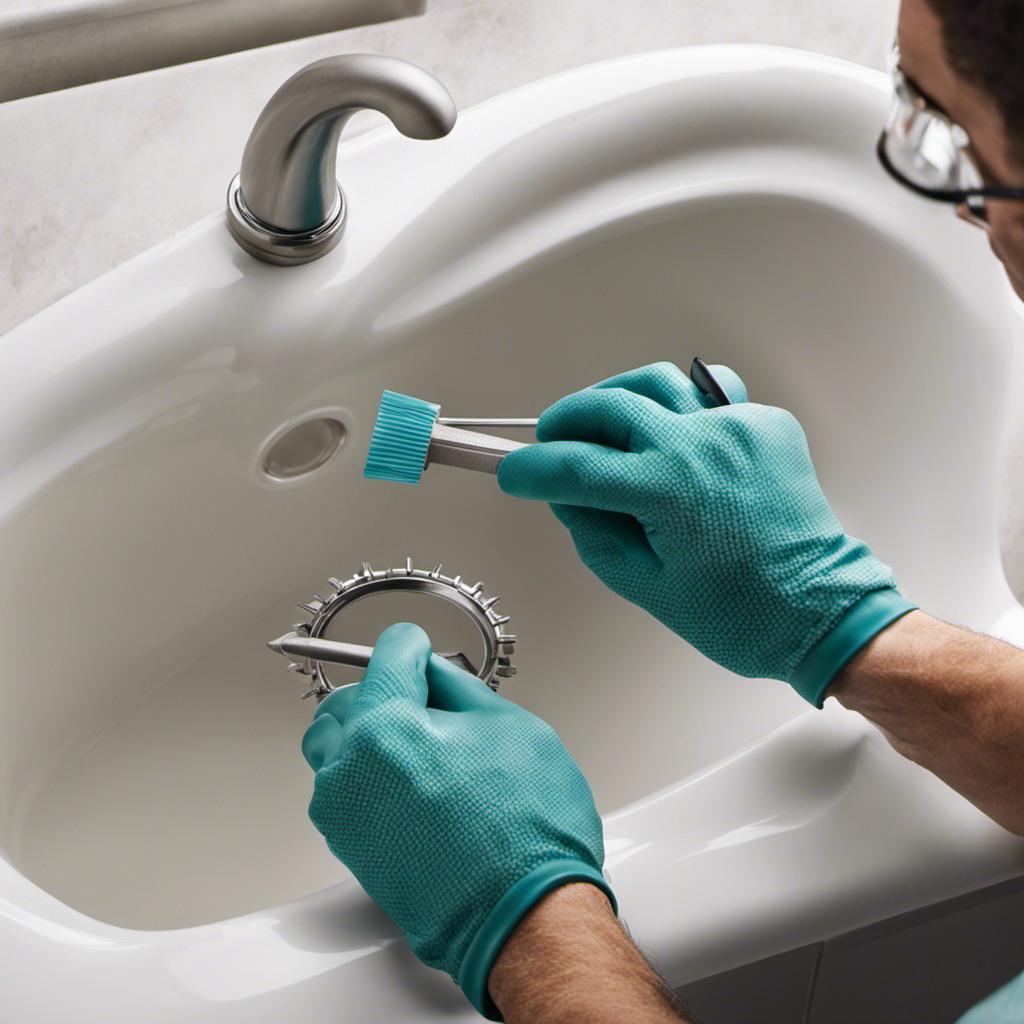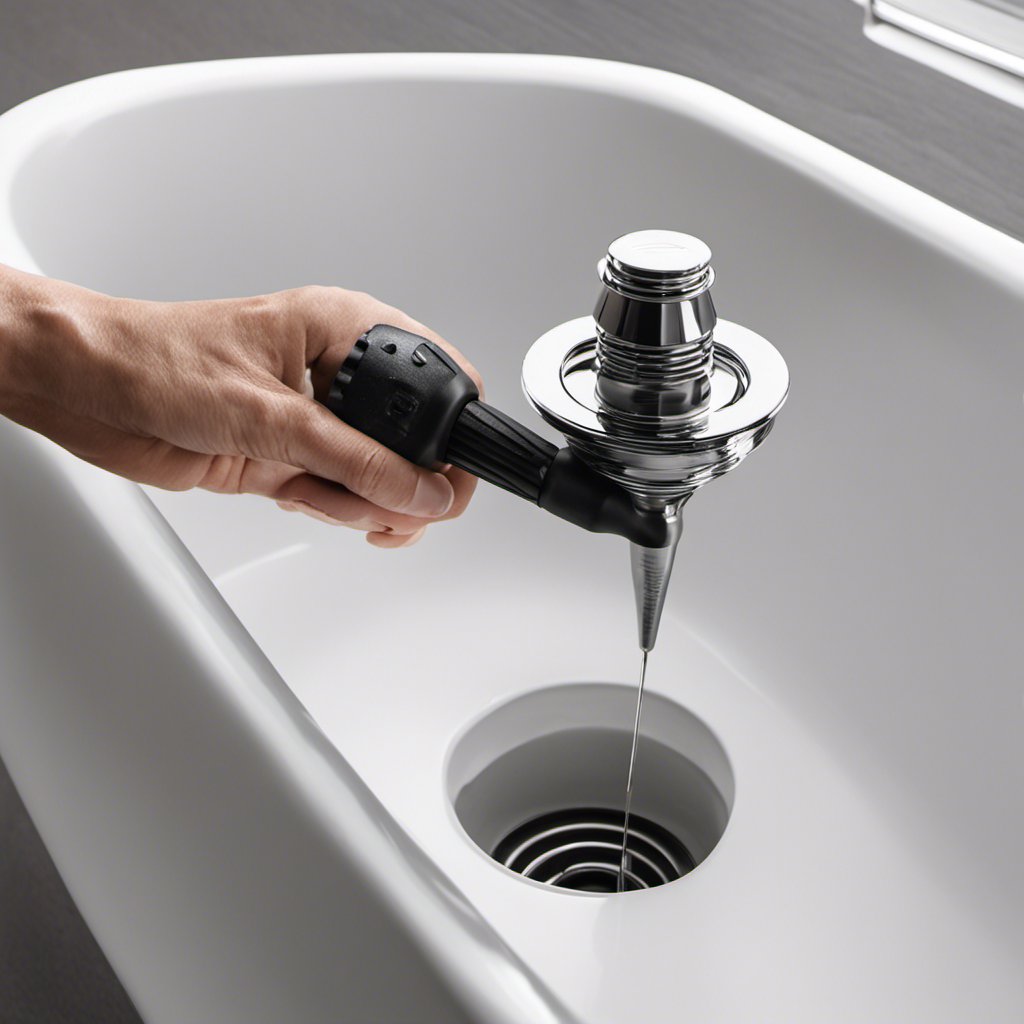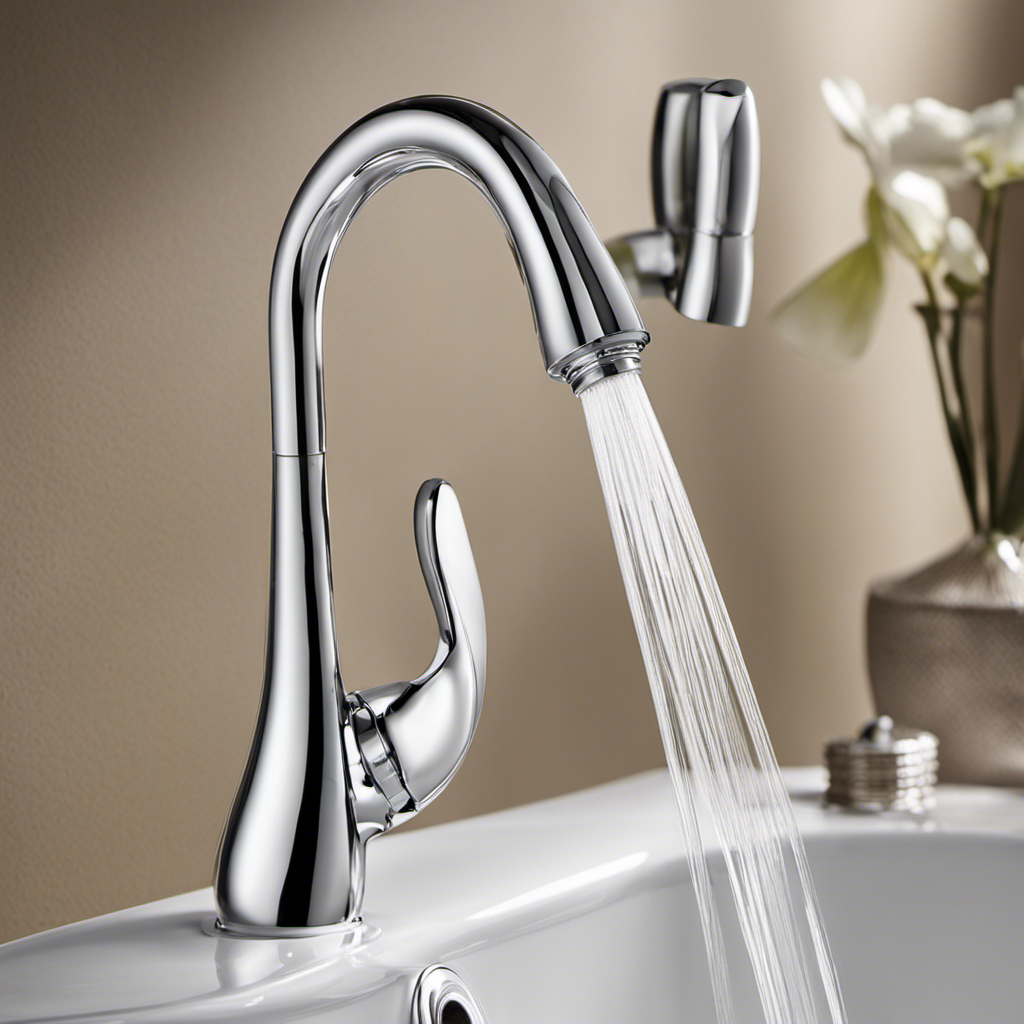So, you’ve found yourself with a stubborn bathtub drain that just won’t budge, huh? Well, fear not, because we’ve got the solution for you.
In this article, we’ll show you exactly how to get that pesky drain out using simple tools and techniques. No need to call a plumber or stress about the task at hand. Just follow our step-by-step instructions and you’ll have that drain out in no time.
Let’s get started, shall we?
Key Takeaways
- Check for visible clogs using a flashlight
- Obtain the necessary tools such as a drain wrench, pliers, and screwdriver
- Familiarize yourself with different types of drain stoppers and the appropriate tools for their removal
- Use the proper tools and techniques to loosen the drain flange and remove it safely
Assess the Problem
First, check if there’s any visible clog in the drain using a flashlight. Assessing the difficulty of removing a bathtub drain is crucial before attempting any repair.
The most common causes of a clogged drain include hair, soap scum, and debris buildup. Start by shining the flashlight down the drain to identify any obstructions. Look for hair clumps or solid objects that may block the water flow.
Next, try using a plunger to dislodge the clog. If the clog persists, it may be necessary to remove the drain completely. This process requires specific tools and expertise.
To gather the necessary tools, you’ll need a screwdriver, pliers, and a drain wrench.
Gather the Necessary Tools
Now, you’ll need a few tools to gather before you begin. Proper tool selection is crucial for successfully removing a bathtub drain.
First, you’ll need a drain wrench or a drain key. This tool is specifically designed to fit the drain and provide a secure grip for turning it counterclockwise.
Additionally, a pair of pliers is essential for gripping and turning the drain if it is difficult to remove.
Another useful tool is a screwdriver, which is used to remove any screws or fasteners securing the drain in place.
Finally, a pair of gloves will protect your hands and provide better grip while applying necessary pressure.
With these tools in hand, you are ready to tackle the task of removing the bathtub drain.
Remove the Drain Stopper
When it comes to removing a drain stopper from your bathtub, it’s important to familiarize yourself with the different types of stoppers that are commonly used. Knowing which type you have will help determine the appropriate tools and techniques for removal.
Some common types include lift-and-turn, push-and-pull, toe-touch, and trip-lever stoppers. To remove these stoppers, you will typically need a pair of pliers, a screwdriver, and possibly a wrench or adjustable wrench, depending on the type of stopper you have.
Different Drain Stopper Types
To remove your bathtub drain, you’ll need to identify the type of drain stopper you have. There are various types of drain stoppers commonly found in bathtubs, each requiring a different approach for removal. Here are three types of drain stoppers you may encounter:
-
Push-pull stopper: This type of stopper can be removed by twisting it counterclockwise and pulling it out.
-
Lift-and-turn stopper: To remove this stopper, you’ll need to lift it up and then turn it counterclockwise before pulling it out.
-
Toe-touch stopper: This stopper can be removed by twisting it counterclockwise and lifting it out using your fingers or a pair of pliers.
Understanding the type of drain stopper you have is crucial for successful bathtub drain maintenance and troubleshooting.
Now that you know how to identify your stopper, let’s move on to the tools needed for removal.
Tools Needed for Removal
You’ll need a few tools for removing the bathtub drain stopper. Proper tool selection is crucial to ensure a smooth removal process. The table below outlines the necessary tools and their functions:
| Tool | Function |
|---|---|
| Screwdriver | Used to remove screws or unscrew the drain cover. |
| Pliers | Used to grip and turn the drain stopper, especially for pop-up stoppers. |
| Drain Key | Specifically designed to remove stubborn or corroded drain stoppers. |
To remove the drain stopper, first, locate the screws or twist-off mechanism securing the drain cover. Use the screwdriver or pliers to remove them. Next, apply necessary pressure to lift or unscrew the drain stopper. If it’s a pop-up stopper, use the pliers to grip and turn counterclockwise. For stubborn stoppers, the drain key is your best bet. Insert it into the drain and turn counterclockwise to release the stopper. With the proper tools and applying necessary pressure, you’ll have that drain stopper out in no time!
Loosen the Drain Flange
To successfully loosen the drain flange, it’s crucial to begin with proper tool selection. Select a tool that is specifically designed for this task, such as a drain key or pliers.
Additionally, lubricating the flange beforehand can aid in the removal process by reducing friction.
Lastly, applying the necessary pressure in a controlled manner will help break the seal and allow for the loosening of the drain flange.
Proper Tool Selection
When removing a bathtub drain, it is important to choose the proper tools for the job. Using the correct tools not only makes the process easier, but it also helps prevent damage to the drain and surrounding surfaces.
Here are three important things to consider when selecting your tools:
-
Make sure to use a screwdriver that fits the screw head properly. Using the wrong size or type of screwdriver can strip the screw, making it difficult to remove.
-
A plunger can be useful in situations where the drain is clogged and you need to remove excess water before working on the drain. It helps create suction and dislodge any debris.
-
An adjustable wrench allows you to grip and turn the drain flange securely. Make sure to adjust it properly to avoid damaging the flange or the wrench slipping.
Proper tool maintenance and avoiding common tool mistakes will ensure a successful bathtub drain removal.
Lubricating the Flange
Lubricating the flange with a silicone-based lubricant can help ease the removal process and prevent any potential damage. Before attempting to remove the drain, it is important to clean it thoroughly to prevent future clogs.
Start by removing any visible debris or hair from the drain using a pair of needle-nose pliers or a drain snake. Next, mix a solution of equal parts baking soda and vinegar and pour it down the drain. Let it sit for about 15 minutes to break down any remaining residue. Afterward, flush the drain with hot water to clear out any remaining debris.
Once the drain is clean, apply the silicone-based lubricant to the flange to ensure smooth and easy removal. This lubrication will also help prevent any damage to the flange or surrounding pipes. Remember to use a silicone-based lubricant specifically designed for plumbing applications, as other lubricants may cause damage or corrosion.
Applying Necessary Pressure
Applying the necessary pressure while removing the drain helps to ensure a secure and tight fit. When it comes to getting a bathtub drain out, it’s important to know how to apply force effectively. Here are some key tips to keep in mind:
-
Use a drain removal tool: This specialized tool is designed to grip the drain tightly, allowing you to apply force without causing damage.
-
Rotate counterclockwise: To remove the drain, you’ll need to rotate it counterclockwise. Applying steady pressure while turning will help loosen the drain from its position.
-
Clear blockages: Before removing the drain, it’s essential to clear any blockages that may be causing it to get stuck. Use a plunger or a drain snake to remove any debris or hair.
Disconnect the Drain Pipe
First, you’ll need to unscrew the drain pipe to disconnect it from the bathtub. This step is crucial when it comes to pipe removal and troubleshooting. To effectively disconnect the drain pipe, follow these simple steps:
-
Locate the drain pipe underneath your bathtub. It is usually found near the bottom, attached to the drain assembly.
-
Using a pipe wrench or pliers, grip the nut that connects the drain pipe to the drain assembly.
-
Rotate the wrench counterclockwise to loosen the nut. Apply steady pressure until the nut is completely unscrewed.
-
Once the nut is removed, gently pull the drain pipe away from the bathtub. Be cautious not to damage any surrounding pipes or fixtures.
Apply Lubricant or Cleaner
To ensure smooth operation, you should regularly maintain the drain pipe by using a lubricant or cleaner. This will help prevent clogs and keep the drain flowing freely.
When it comes to cleaning methods for the drain pipe, there are a few options you can consider:
-
Use a drain cleaning solution: There are various commercial drain cleaners available that can effectively dissolve buildup and debris in the pipe.
-
Try a homemade solution: Mix equal parts of baking soda and vinegar, pour it down the drain, and let it sit for about 30 minutes before flushing it with hot water. This can help break down any organic matter clogging the pipe.
-
Consider using a drain snake: If you prefer a more hands-on approach, a drain snake can be used to physically remove any blockages from the pipe.
Regardless of the cleaning method you choose, it’s important to be cautious and aware of potential hazards. Always follow the instructions on the cleaning product and wear protective gloves to avoid any contact with harsh chemicals.
Remove the Bathtub Drain
One common method for removing the bathtub drain is by using a drain removal tool. This tool is specifically designed to fit into the drain and provide the necessary leverage to unscrew it.
To begin, you will need to locate the set screw on the drain flange and use a screwdriver to loosen it. Once the set screw is loose, insert the drain removal tool into the drain and turn it counterclockwise to loosen the drain.
Continue turning until the drain is completely removed from the bathtub. It is important to note that proper bathtub drain installation and maintenance can prevent the need for removing it in the future. Regular cleaning and checking for any blockages or leaks will help ensure the longevity of your bathtub drain.
Frequently Asked Questions
How Do I Know if My Bathtub Drain Is Clogged?
If your bathtub drain is clogged, there are a few signs to look out for, such as slow draining and water pooling. You can try unclogging it without chemicals by using a plunger or a drain snake.
What Tools Do I Need to Remove a Bathtub Drain?
To remove a bathtub drain, you’ll need a few necessary tools. These tools include a screwdriver, pliers, and a drain removal tool. With these tools, you can successfully remove the bathtub drain.
Can I Use a Plunger to Unclog a Bathtub Drain?
Yes, you can use a plunger to unclog a bathtub drain. It’s an effective method that creates suction to dislodge the blockage. However, if the plunger doesn’t work, there are alternative unclogging methods available.
Is It Necessary to Remove the Drain Stopper Before Removing the Drain Flange?
Before removing the drain flange, it is important to take out the drain stopper. This step ensures proper maintenance and allows for easier access to the drain. Don’t neglect this crucial task!
How Often Should I Clean or Lubricate My Bathtub Drain to Prevent Clogs?
To prevent bathtub drain clogs, it is important to regularly clean and lubricate your drain. This maintenance will keep the drain flowing smoothly and prevent buildup. Make it a habit for optimal results.
Conclusion
So there you have it – a step-by-step guide on how to get a bathtub drain out. By following these instructions, you’ll be able to tackle this task with ease and have your drain removed in no time.
Remember, it’s always important to assess the problem and gather the necessary tools before starting. And don’t worry about it being too difficult or time-consuming, because with a little patience and the right technique, you’ll be able to successfully remove the drain and keep your bathtub in top shape.
Happy fixing!










